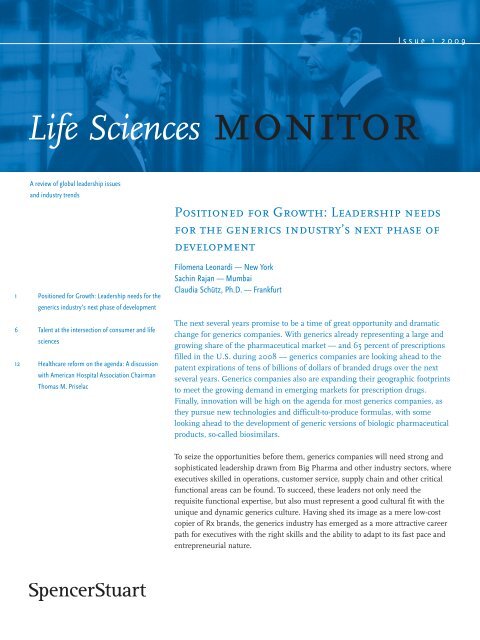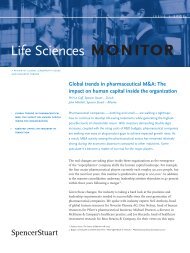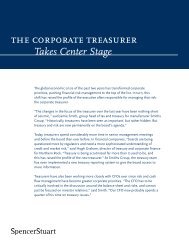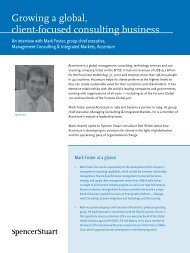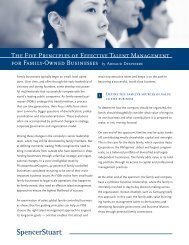Life Sciences monitor - Spencer Stuart
Life Sciences monitor - Spencer Stuart
Life Sciences monitor - Spencer Stuart
Create successful ePaper yourself
Turn your PDF publications into a flip-book with our unique Google optimized e-Paper software.
1<br />
6<br />
12<br />
<strong>Life</strong> <strong>Sciences</strong> <strong>monitor</strong><br />
A review of global leadership issues<br />
and industry trends<br />
Positioned for Growth: Leadership needs for the<br />
generics industry’s next phase of development<br />
Talent at the intersection of consumer and life<br />
sciences<br />
Healthcare reform on the agenda: A discussion<br />
with American Hospital Association Chairman<br />
Thomas M. Priselac<br />
I s s u e 1 2 0 0 9<br />
Positioned for Growth: Leadership needs<br />
for the generics industry’s next phase of<br />
development<br />
Filomena Leonardi — New York<br />
Sachin Rajan — Mumbai<br />
Claudia Schütz, Ph.D. — Frankfurt<br />
The next several years promise to be a time of great opportunity and dramatic<br />
change for generics companies. With generics already representing a large and<br />
growing share of the pharmaceutical market — and 65 percent of prescriptions<br />
filled in the U.S. during 2008 — generics companies are looking ahead to the<br />
patent expirations of tens of billions of dollars of branded drugs over the next<br />
several years. Generics companies also are expanding their geographic footprints<br />
to meet the growing demand in emerging markets for prescription drugs.<br />
Finally, innovation will be high on the agenda for most generics companies, as<br />
they pursue new technologies and difficult-to-produce formulas, with some<br />
looking ahead to the development of generic versions of biologic pharmaceutical<br />
products, so-called biosimilars.<br />
To seize the opportunities before them, generics companies will need strong and<br />
sophisticated leadership drawn from Big Pharma and other industry sectors, where<br />
executives skilled in operations, customer service, supply chain and other critical<br />
functional areas can be found. To succeed, these leaders not only need the<br />
requisite functional expertise, but also must represent a good cultural fit with the<br />
unique and dynamic generics culture. Having shed its image as a mere low-cost<br />
copier of Rx brands, the generics industry has emerged as a more attractive career<br />
path for executives with the right skills and the ability to adapt to its fast pace and<br />
entrepreneurial nature.
L i f e S c i e n c e s M o n i t o r<br />
2<br />
To further explore how the generics industry has<br />
changed and the impact on companies’ leadership<br />
needs, consultants in <strong>Spencer</strong> <strong>Stuart</strong>’s <strong>Life</strong> <strong>Sciences</strong><br />
Practice spoke with senior leaders of generics<br />
businesses around the world about their strategies<br />
for the future, their evolving leadership needs and<br />
how the industry is addressing its talent needs.<br />
Looking ahead: Generics industry trends<br />
While they have many exciting opportunities<br />
before them, generics companies also face a variety<br />
of challenges. Pricing pressure continues to grow,<br />
due to intense competition and, in some markets,<br />
the consolidation of retail customers and efforts<br />
by retailers or governments to lower drug prices.<br />
Innovation is required, yet investments in new<br />
technologies will be substantial and, especially in<br />
the case of biologics, may be out of reach for many<br />
companies. Many companies that grew opportunistically<br />
in the past are finding that long-term<br />
success requires them to evolve to more strategic,<br />
sustainable approaches to the business today. As the<br />
gap between industry leaders and new entrants<br />
widens, it is ever more important that companies<br />
define the right strategies for their organizations<br />
and execute flawlessly.<br />
Regardless of companies’ specific strategies,<br />
improving time to market and achieving economies<br />
of scale remain fundamental to success in generics.<br />
Speed and price have been the traditional drivers of<br />
the generics industry; improving performance in<br />
these areas is an even greater imperative today.<br />
Generics companies are facing pressure from<br />
multiple directions; on the pricing side, competition<br />
from lower-priced entrants and negotiated cost<br />
controls from retailers and governments are reducing<br />
margins, while the costs related to registering<br />
products and litigating patents have grown.<br />
“Price will be the dominant factor for the business,”<br />
observed Hans-Helmut Fabry, country head Sandoz<br />
Germany. “The challenge for generics companies is<br />
less about managing the life cycle of products than<br />
managing the price cycle.”<br />
The attention to cost suggests that generics<br />
companies will be more strategic in evaluating<br />
which opportunities make sense for them to pursue,<br />
including which molecules, formulas, delivery forms<br />
and technologies to invest in or develop. Generics<br />
companies and their leaders must understand what<br />
their companies do well and make sure they pursue<br />
only those opportunities where they can excel.<br />
“Generics companies traditionally have been<br />
extremely opportunistic and the entire approach has<br />
been to try and grab opportunities as they present<br />
themselves,” argued Saumen Chakraborty, president<br />
of corporate and global generics operations for Dr.<br />
Reddy’s Laboratories. “The shift now is toward a<br />
more strategic, sustainable approach providing more<br />
consistent performance,” he said. “As you move to<br />
this more strategic mindset, the big difference is that<br />
you need to start calibrating across the entire value<br />
chain from end to end and this applies to your<br />
investments as well.”<br />
A major focus will be innovating improvements<br />
designed to lower costs across the value chain. As<br />
they expand in size and geographic reach, generics<br />
companies are looking for more strategic and costeffective<br />
ways of operating. For example, many<br />
companies are evaluating whether to centralize<br />
certain functions into global roles to derive<br />
economies of scale. While commercial roles and<br />
others that require local relationships will remain<br />
local or regional functions, others — such as<br />
research and development, manufacturing and<br />
elements of supply chain — may well be more<br />
efficiently managed if centralized.<br />
Amar Lulla, chief executive and joint managing<br />
director of Cipla, said he expects the entire<br />
organization to focus on improving performance<br />
and reducing costs. “Innovation has to focus on<br />
finding new ways to work and creating new<br />
efficiencies. It has to be ingrained in the genetic code<br />
of the organization. We need to be prepared to see<br />
everything we do differently. Whether it is a product,<br />
marketing, launches, logistics or distribution, we
“The generics industry has emerged as distinctly different from other industries;<br />
as such, no other life sciences or consumer sector represents an exact match for<br />
leadership talent.”<br />
want to do everything in a manner that is more efficient<br />
and innovative.”<br />
With competition on the rise and customers<br />
consolidating, strong customer relationships and<br />
customer service have never been more important.<br />
In addition to controlling costs, generics companies are<br />
focused on ensuring product quality, providing excellent<br />
customer service through product assortment and<br />
reliable delivery and staying close to customers and<br />
market developments. Executives said they do this by<br />
limiting the number of organizational layers, remaining<br />
adaptable and working closely with customers.<br />
“You need to be linked within the customer’s DNA,<br />
from the top of the organization down to the bottom,”<br />
said William S. Marth, president and CEO of Teva<br />
North America. One way Teva builds these rich<br />
customer relationships is by closely aligning its<br />
distribution with key customers. “We put product<br />
where they want it, the moment they want it.”<br />
Addressing the generics industry talent shortage<br />
Generics companies are facing a talent shortage —<br />
and it is not just a matter of numbers. Not only<br />
will generics companies need more leaders in a wide<br />
variety of positions to address growth and the new<br />
opportunities before them, the required skill-sets<br />
represent a composite of capabilities that will have<br />
to be found from multiple industries. The generics<br />
industry has emerged as distinctly different from other<br />
industries; as such, no other life sciences or consumer<br />
sector represents an exact match for leadership talent.<br />
So, where will the generics industry find the leaders for<br />
tomorrow? Traditional pharmaceutical businesses will<br />
continue to be a source of executive talent for roles in<br />
research and product development. To fill commercial<br />
roles, generics companies are likely to look for talent<br />
across a wider breadth of life sciences sectors and in<br />
other more regulated industries, such as over-thecounter<br />
(OTC) drugs and consumer healthcare products.<br />
Finally, as they continue to seek out new ideas and<br />
best practices from other industries to take operations<br />
and market-facing functions to the next level of<br />
sophistication, generics companies will have to look<br />
outside life sciences. For example, general managers<br />
and commercial leaders may be found in retail or fastmoving<br />
consumer goods, where speed, customer insight<br />
and the ability to work in a tight-margin environment<br />
are critical. Sectors with strong manufacturing and<br />
supply chain operations, such as electronics or automotive,<br />
may be good sources for senior-level operational<br />
leaders. Those industries that produce executives who<br />
are highly trained in Six Sigma principles and practices<br />
may prove to be especially valuable sources of talent.<br />
General managers and other senior leaders must have<br />
a broader skill-set than in the past and be capable of<br />
managing the growing complexity of the generics<br />
business. These must be “hands-on” leaders who<br />
also are solid strategic thinkers willing to explore<br />
counterintuitive approaches to the traditional ways<br />
of doing business. They must have excellent communication<br />
and influencing skills and exceptional<br />
professional credentials.<br />
“Leaders need to be analytical, able to strategize on<br />
a process and stay with the facts,” said Fabry. “They also<br />
have to be able to turn around quickly, improvise and go<br />
in a different direction. Executives should be agile and<br />
eager to learn. They should have an international<br />
mindset and be credible and empathetic to the<br />
organization.” Horst Uwe Groh, global head of HR<br />
for Sandoz International, said Sandoz has similar<br />
3
L i f e S c i e n c e s M o n i t o r<br />
4<br />
priorities when recruiting. “When we look outside for<br />
talent, the most important priorities are to find people<br />
with a multicultural mindset, who are more focused<br />
and aggressive than others. They have to have a sense<br />
of urgency. The generics industry is becoming<br />
increasingly professional and education is more<br />
relevant than ever,” he said.<br />
At the same time, leaders must be taskmasters when it<br />
comes to wringing out costs, improving efficiency and<br />
delivering product to market, argued Chakraborty.<br />
“Speed and execution are going to be absolutely<br />
critical, more than ever, and that is going to take a<br />
degree of hard taskmaster kind of leadership.”<br />
Companies also will have specific talent needs based<br />
on their strategies. For example, as they pursue the<br />
development of biosimilars, Teva and Watson are<br />
building their technical and R&D capabilities and<br />
expect to need additional marketing and sales muscle<br />
as well. “To be successful going forward, we’re going<br />
to have to select the right products, have the right<br />
people in place to develop those products, test them,<br />
do the right clinical studies and then work through<br />
the legal and regulatory morass to get those products<br />
to market,” said Paul M. Bisaro, CEO of Watson<br />
Pharmaceuticals. “Therefore, we will need additional<br />
Ph.D.s and chemists, the clinical people to design and<br />
run the necessary clinical studies, and the marketing<br />
and sales teams to manage the different models for<br />
generic biologics.”<br />
Similarly, Cipla’s model — which focuses on<br />
developing different delivery models for molecules<br />
where safety and efficacy are well-established —<br />
requires leaders with a unique mindset. “We’re trying<br />
to do things to improve a patient’s quality of life or<br />
compliance, such as combining three drugs into one<br />
inhaler so the patient gets the full treatment in one<br />
dose,” Lulla said. “This is a different mindset from a<br />
more discovery-oriented one.”<br />
As they recruit executives from other industries,<br />
companies will have to look for people open to being<br />
“retooled” for the generics industry. Those who bring<br />
functional expertise, but are unable to adapt to the<br />
unique generics culture, are unlikely to excel. Executives<br />
from branded pharmaceutical businesses have<br />
the right skills and expertise for many roles — and<br />
more are available in some markets due to consolidation<br />
in the pharmaceutical business. However, to be<br />
successful in generics, these executives must be able<br />
to move in a fast-paced environment, work within<br />
tighter margins and understand that innovation<br />
doesn’t just come from the lab, but from the whole<br />
value chain. Meanwhile, executives from retail or<br />
FMCG companies are attractive based on their proven<br />
ability to work within a fast-paced environment that is<br />
focused on customer service, but have to adapt to the<br />
demands and constraints of a regulated environment.<br />
OTC and other consumer healthcare executives, who<br />
already straddle the consumer and regulated worlds,<br />
may have an easier transition to generics.<br />
An overarching challenge for generics companies<br />
will be to find the leaders with the mindset to adapt<br />
to the generics business — whether they come from<br />
traditional pharmaceutical companies or from outside<br />
of life sciences entirely. “The generics business is built<br />
around entrepreneurship and speed of action. We<br />
try to make decisions in short order, not in a month’s<br />
timeframe. Some people can easily make that<br />
transition, and others do not. The talent is out<br />
there. The question is, can they assimilate into a<br />
new culture?” said Bisaro.<br />
U. Mark Schneider, president and CEO of Fresenius<br />
Group, agrees that generics has a distinctly different<br />
pace than other healthcare segments. “In generics,<br />
there is a greater sense of urgency and a unique<br />
culture. It’s more entrepreneurial. Generics companies<br />
don’t have the same long-term horizon as branded<br />
pharmaceutical businesses. It’s all about fast decision<br />
making and achieving a high hit rate — playing<br />
hockey rather than chess. They are also much more<br />
cautious about spending and watch selling, general<br />
and administrative costs like a hawk.” Generics<br />
company executives said their leaders are empowered
to experiment and make decisions, without lengthy<br />
approval processes or “decisions by committee.”<br />
Marth uses a basketball analogy to explain the<br />
expectations on Teva’s leaders. “We have a philosophy<br />
that if there are three seconds left in the game and<br />
you have the ball, take the shot. I tell that to our<br />
customers. I tell it to our employees. I want you to<br />
take the shot. I didn’t give you the ball to pass it.<br />
You’re never going to get punished here for having<br />
tried and failed, but you have to be accountable.”<br />
Conclusion<br />
The traditional path to success in generics will not be<br />
the way of the future. The business today is more<br />
complex and requires strategic and sophisticated<br />
leaders who operate with a sense of urgency and an<br />
eye to continually improving efficiency.<br />
Because of the industry’s fast growth and the<br />
changing nature of the business, generics companies<br />
will have to look outside the sector for new talent.<br />
Sources of talent include the retail, fast-moving<br />
consumer goods and traditional pharmaceutical<br />
industries as well as businesses with strong<br />
manufacturing and supply chain operations, such as<br />
electronics or automotive. The challenge will be to<br />
incorporate the ideas and best practices these new<br />
leaders bring, while maintaining a culture that<br />
promotes the speed and efficiency so critical to the<br />
success of generics companies.<br />
How can companies in this dynamic and growing<br />
industry make sure they have the right talent? We<br />
offer several considerations below.<br />
> Understand that executives from other industries<br />
will have to be “retooled” if they are to be<br />
successful in the generics industry. Pharmaceutical<br />
executives have the technical knowledge and<br />
understand the regulatory aspects of the role, but<br />
may be less prepared for generics’ fast pace and<br />
sense of urgency. Meanwhile, executives from lessregulated<br />
industries may be comfortable with the<br />
industry’s speed and thin margins, but have to<br />
adjust to operating within regulatory frameworks.<br />
> Companies must identify the core capabilities<br />
of leaders who are able to transition between<br />
industries and recruit executives who have a<br />
demonstrated track record of successful transitions.<br />
Individuals who have had to be agile under new<br />
conditions, such as an international assignment,<br />
often have the mindset required to make the<br />
transition.<br />
> Changes in the pharmaceutical business may<br />
make it easier for generics companies to recruit<br />
and transition pharma leaders in the future. As<br />
Schneider explained, “The pharmaceuticals and<br />
generics industries once represented the extremes<br />
of entrepreneurship. Today, pharma leaders regard<br />
the pace, flexibility and entrepreneurship of the<br />
generics industry very highly. The readiness of both<br />
sides to learn from each other has increased.”<br />
About the authors<br />
Based in New York, Filomena Leonardi is a<br />
member of <strong>Spencer</strong> <strong>Stuart</strong>’s <strong>Life</strong> <strong>Sciences</strong> Practice,<br />
focusing on the pharmaceutical and biotechnology<br />
sectors. Within those sectors, she leads recruiting<br />
assignments for senior-level positions in research<br />
and development, sales and marketing and<br />
general management.<br />
Based in the firm’s Mumbai office, Sachin Rajan is<br />
a member of the firm’s <strong>Life</strong> <strong>Sciences</strong>, Technology,<br />
Communications & Media and Consumer Goods &<br />
Services practices. He recruits senior-level executives<br />
to leadership positions in these sectors.<br />
Claudia Schütz is a member of the firm´s <strong>Life</strong><br />
<strong>Sciences</strong> and Human Resources practices, and is<br />
based in Frankfurt. She has extensive experience<br />
recruiting top executives, including CEOs, general<br />
managers, marketing, sales and human resources<br />
directors across industry functions as well as seniorlevel<br />
positions in specialized functions, such as<br />
research and development.<br />
5
L i f e S c i e n c e s M o n i t o r<br />
6<br />
Talent at the intersection of consumer and<br />
life sciences<br />
Eric Leventhal — New York, with contributions from Mark Broer — London<br />
The healthcare industry is on the precipice of enormous change that will play out in the months and years<br />
to come. The Merck/Schering-Plough and Pfizer/Wyeth deals stand as Exhibits A and B for the next round<br />
of life sciences industry consolidation. But an important and relatively unexamined subtext to these macroindustry<br />
trends is the future role of consumer businesses in the context of Big Pharma.<br />
Historically, the consumer divisions of Big Pharma<br />
have been relegated to mere footnotes in company<br />
earnings announcements or press releases,<br />
especially when compared to the “star” status<br />
afforded to the much larger and highly profitable<br />
prescription drug businesses.<br />
However, as blockbuster drugs go off patent,<br />
regulatory processes grow more complicated and<br />
pharmaceutical companies seek external partners to<br />
rebuild their pipelines, the perception of consumer<br />
health divisions has changed. Many Big Pharma<br />
companies now see their consumer businesses —<br />
ranging from over-the-counter drugs, nutritionals/<br />
supplements, oral healthcare and dermatological<br />
products — as valuable and consistent sources of<br />
cash flow and profit, off-setting the peaks and valleys<br />
of the Rx business. While they may not enjoy the<br />
profit margins of prescription drugs, the consumer<br />
businesses don’t require nearly the same lead time or<br />
upfront investment in research and development.<br />
And, in fact, the aggregate net sales of consumer<br />
divisions within the world’s top 15 Big Pharma<br />
companies amount to a very meaningful $40 billion.<br />
To further explore the evolution of the consumer<br />
healthcare business and the industry’s talent needs,<br />
consultants in <strong>Spencer</strong> <strong>Stuart</strong>’s Consumer Goods &<br />
Services and <strong>Life</strong> <strong>Sciences</strong> practices interviewed<br />
senior industry executives to explore the changing<br />
landscape and define how these changes impact the<br />
leadership profile.<br />
Building a portfolio for growth<br />
Shortly after taking over as CEO of GlaxoSmithKline,<br />
Andrew Witty made it clear to the company and its<br />
investors that a strong and growing consumer<br />
healthcare business would be a core element of<br />
GSK’s strategy. Although it represents just 15<br />
percent of the company’s overall revenue, the<br />
consumer business had built a track record of<br />
double-digit growth. In addition to providing a<br />
steady stream of revenue and profits, the consumer<br />
business serves as a platform for growth in<br />
emerging markets, where drugs are sometimes<br />
sold by pharmacists without a prescription and<br />
paid for privately.<br />
“While the pharmaceutical business is an extremely<br />
good one, there is a real opportunity to be more<br />
diversified in terms of where we source our<br />
earnings,” said Tim Wright, who leads GSK’s Future<br />
Group, which oversees the innovation and marketing<br />
efforts for the company’s seven global consumer<br />
healthcare brands.<br />
GSK is not alone among Big Pharma companies<br />
in elevating their consumer health businesses,<br />
which are becoming more global and more<br />
strategic to their parent companies. And as these<br />
businesses play a more important role, companies<br />
have increased their investment in people and<br />
infrastructure to support them, building more<br />
sophisticated teams and, in many cases,<br />
restructuring to create autonomous, stand-alone<br />
consumer organizations.
These new business units require different leaders<br />
than the consumer healthcare leaders of the past.<br />
Traditionally, consumer talent was spread across<br />
global operations and was deeply embedded in<br />
regional teams, which primarily focused on the<br />
Rx business. Local consumer executives were<br />
commercial leaders whose main role was to<br />
manage relationships with distributors and<br />
partners. Ideas were imported from corporate<br />
headquarters and the goal was to execute these<br />
ideas well in the field. Much smaller than the Rx<br />
business in any single region, the consumer<br />
business often didn’t receive the management focus<br />
and support it needed to grow. Many companies we<br />
interviewed have evolved to a new model in which<br />
regional or country general managers run the<br />
consumer business as a stand-alone unit within<br />
their respective geographies and report to a global<br />
consumer leader. Even at the country business unit<br />
level, these leaders oversee full cross-functional<br />
teams, including sales, marketing, finance, human<br />
resources and supply chain. Beyond supporting<br />
ideas and programs generated from headquarters,<br />
regional and country leaders are expected to<br />
generate their own new product and business<br />
development ideas — and share them globally.<br />
Emerging profile: Characteristics of the new<br />
consumer healthcare leader<br />
In light of their higher profile in the organization<br />
and the increased demands they face, consumer<br />
healthcare leaders today must possess a broad set<br />
of high-level skills and capabilities, including<br />
the following:<br />
A strategic mindset<br />
Consumer healthcare leaders face new expectations<br />
because of their businesses’ aggressive growth<br />
targets and global strategies. They are responsible<br />
for the key strategic decisions within their regions<br />
and contribute to discussions about which brands<br />
have the potential to be global and which are likely<br />
to remain regional or local.<br />
To achieve its goal of becoming a top-10 player in<br />
the consumer healthcare space, Merck’s consumer<br />
business plans on roughly doubling its current<br />
revenue, said Peter Shotter, president of Merck<br />
Consumer Health Care for Merck KGaA. “To do<br />
that, we need people who are good at what they do<br />
and have the courage of their convictions. Of<br />
course, the sort of leadership team you have in a<br />
business like ours is going to be very results-driven.<br />
They’re going to have good customer orientation<br />
and consumer orientation. They’re going to have<br />
strong strategic skills in terms of where to take the<br />
business,” he said.<br />
Because they tend to have smaller organizations<br />
than the traditional Rx business and the products<br />
have a shorter time-to-market, leaders of consumer<br />
healthcare businesses must possess a sense of<br />
urgency and ownership. “Our top leaders own key<br />
issues. They roll up their sleeves and dig in. They’re<br />
not people who ask for an analysis and wait two<br />
months. That sense of urgency and the ability to go<br />
deep is something we look for,” said Larry Allgaier,<br />
global head of Novartis OTC.<br />
Business development skills<br />
Business development, including M&A, partnerships<br />
and joint ventures, has emerged as a core<br />
competency for consumer healthcare leaders at<br />
many companies.<br />
“My expectation is that our country business unit<br />
managers will all be business development hunters<br />
in addition to running our business day-to-day,”<br />
said Brent Saunders, president of Schering-Plough<br />
Consumer. “They should be looking for and proposing<br />
local product business development. We may<br />
not do them all and they may not find anything<br />
worthwhile, but I expect them all to try.”<br />
Local knowledge and relationships<br />
Consumer healthcare leaders also require an<br />
external orientation and knowledge about the local<br />
market and regulatory framework. “There is an<br />
7
L i f e S c i e n c e s M o n i t o r<br />
“To be successful, you need the marketing acumen of a consumer-driven company<br />
and the ability to inject consumer insight into R&D. General management must<br />
have a fine balance of both.”<br />
8<br />
ambassadorship, a consistent collaboration with<br />
regulatory authorities, with NGOs (nongovernmental<br />
organizations) and with the key opinion leaders,” said<br />
Ashley McEvoy, formerly the president of J&J’s<br />
McNeil Consumer division and now worldwide<br />
president of Ethicon Products. “In many of these<br />
countries, you can’t do business by yourself — you<br />
have to enter into a partnership with a local company<br />
— so you need good business collaboration, leadership<br />
and influencing skills. Leaders also have to be<br />
able to build a team of highly entrepreneurial creative<br />
leaders because in many of these regions, they are not<br />
getting fed from centralized global resources.”<br />
Schering-Plough’s country managers are expected<br />
to become “insiders” in their country, said Saunders.<br />
“That means they develop relationships with customers.<br />
That means they do local business development.<br />
That means they know the key regulatory people<br />
within their country or have access to ask questions to<br />
the appropriate regulatory officials to move things<br />
forward. They need to understand the marketing<br />
needs and requirements of their local system,”<br />
he said.<br />
Ability to influence local consumers and professionals<br />
A core skill for consumer healthcare leaders — like<br />
leaders of any consumer business — is the ability to<br />
understand consumer preferences and behaviors and<br />
apply consumer insights to the business, executives<br />
said. Leaders of consumer healthcare businesses also<br />
have to have strong commercial skills.<br />
“You have to focus on the consumer marketing skills,<br />
of course, but also the trade marketing skills. Those<br />
are commercial skills, driving point-of-sale visibility.<br />
It’s the combination of those two areas that are the<br />
core,” said Shotter.<br />
McEvoy added, “I like to say that, if you open up<br />
the doors to the back office, we’re a mini pharmaceutical<br />
company. We’re regulated like a drug<br />
company, but our front end is very consumer-like.<br />
We show up in consumers’ medicine cabinets, so we<br />
have to think about things like what the packaging<br />
looks like. To be successful, you need the marketing<br />
acumen of a consumer-driven company and the<br />
ability to inject consumer insight into R&D. General<br />
management must have a fine balance of both.”<br />
Consumer experience wanted<br />
The skill-set that has emerged for general managers<br />
in the consumer healthcare product arena suggests<br />
that, as companies continue to build their leadership<br />
teams, the consumer packaged goods (CPG) industry<br />
will provide a good source of talent. We believe that<br />
one of the key factors that should pave the path for<br />
transition between CPG and consumer health is the<br />
ongoing convergence of sectors such as OTC,<br />
nutrition and supplements, personal care and beauty,<br />
and functional food and beverage, all of which are<br />
chasing the same consumer end benefit of “wellness.”<br />
This convergence has lowered some of the traditional<br />
hurdles that made it difficult for executives to change<br />
sectors, and made expertise in one category more<br />
transferable to another.<br />
The executives we interviewed agreed that a strong<br />
background in sales, marketing and general<br />
management within consumer goods provides an<br />
excellent foundation for consumer healthcare<br />
leadership. It has long been held that CPG experience<br />
helps executives develop critical skills in strategic<br />
planning, P&L management, competitive analysis, the<br />
ability to understand and apply consumer insights to<br />
initiatives and strong advertising and brand building.
Debra Sandler, worldwide president of McNeil<br />
Nutritional, Johnson & Johnson, said executives with<br />
consumer marketing training often have “the longest<br />
runway” as leaders. “What makes them the strongest?<br />
They are trained to communicate effectively. They are<br />
trained to analyze situations quickly and put together<br />
an effective plan. The really good marketers are able<br />
to do that in a cross-functional way. They understand<br />
the business from varying viewpoints and recognize<br />
that all of the functions have to move along in the<br />
same direction. Some other functions, by contrast,<br />
often see themselves as independent.”<br />
And, in fact, entrepreneurial CPG executives are<br />
more likely than in the past to see consumer<br />
healthcare businesses as an attractive career path<br />
because of the wellness trend and the increased<br />
prominence of consumer healthcare businesses. In<br />
some cases, consumer healthcare businesses offer<br />
a faster track to senior positions, said Christian Neu,<br />
president of Danone Baby Nutrition. “There is more<br />
flexibility here than in some CPG companies, and<br />
one can take on more responsibility earlier in their<br />
careers than at others.”<br />
Avoiding the pitfalls<br />
Classically trained consumer executives bring<br />
valuable business and marketing skills, but<br />
consumer healthcare businesses must recruit<br />
thoughtfully and carefully integrate CPG leaders.<br />
One of the biggest challenges for these leaders can be<br />
a lack of appreciation for the different regulatory<br />
aspects of the role compared with pure consumer<br />
businesses. Some former CPG executives can grow<br />
impatient by the longer product development and<br />
approval cycles for consumer healthcare products.<br />
“A lot of times, consumer product people come into<br />
consumer health with great ideas about how they’re<br />
going to hit a home run, not recognizing that the<br />
regulatory scheme is incredibly complex compared to<br />
the standard CPG world and requires a lot of forward<br />
thinking,” said Saunders. “For example, if you have a<br />
great idea for a product in China, you may have to<br />
wait two, three or four years to get the regulatory<br />
approval to launch that product. So, you have to have<br />
much longer thought horizons. You have to build<br />
your pipeline strategically and you have to be patient.<br />
Once you get approval, it’s a very dynamic environment<br />
and, because you have to operate in a very<br />
complex regulatory scheme, good planning is critical<br />
to success.”<br />
Potential conflicts also arise because of the<br />
difference between the way traditional CPG<br />
companies approach “health” and the process<br />
consumer healthcare companies undertake to<br />
demonstrate a health claim, said Sandler. “CPG<br />
companies do not have the same hard-core clinical<br />
and regulatory framework. Food companies may use<br />
GRAS (generally recognized as safe) ingredients.<br />
And while these are in fact safe for consumption,<br />
healthcare scientists and lawyers often have concerns<br />
about these types of ingredients because they do not<br />
always have the body of scientific evidence preferred<br />
for pharmaceutical products. They’re concerned<br />
when food marketers walk in the door because they<br />
feel strongly that they don’t understand how it’s done<br />
in real healthcare.”<br />
Can companies avoid the pitfalls when recruiting<br />
executives with a traditional consumer background?<br />
Consumer healthcare executives shared best practices<br />
for recruiting and assimilating consumer executives<br />
into their organizations.<br />
Clearly communicate the differences between a<br />
classic consumer company and a consumer<br />
healthcare business.<br />
During the interview, emphasize the impact of the<br />
regulatory framework on the product development<br />
process and timing and marketing approaches.<br />
Convey the importance of respecting the scientific<br />
and regulatory processes.<br />
“Consumer-trained executives sometimes become<br />
frustrated when they join a more regulated market<br />
because those fast-to-market initiatives are more<br />
9
L i f e S c i e n c e s M o n i t o r<br />
10<br />
limited in over-the-counter, particularly in countries<br />
outside the U.S., where regulatory approvals almost<br />
approach a drug approval in length. So, we have to<br />
be careful when we hire people from the consumer<br />
world to make sure they understand that,” said Gary<br />
Balkema, worldwide president of the consumer care<br />
division for Bayer HealthCare.<br />
Thoroughly vet candidates for their cultural fit and<br />
orientation<br />
In general, CPG executives who transition<br />
successfully recognize the different challenges they<br />
could face in learning to work within the regulatory<br />
framework, but also have a performance-focused,<br />
roll-up-your-sleeves orientation and a mindset open<br />
to learning. It’s important to make sure candidates<br />
represent a good fit with that culture.<br />
“One of the things that I try to probe for during the<br />
interview process and reference checks is whether<br />
the candidate is a self-starter — whether the person<br />
can stand on his or her own two feet and can take<br />
ownership for a business or grow a business without<br />
a lot of hand-holding and one-on-one interaction with<br />
headquarters,” said Saunders.<br />
Successful executives often demonstrate these<br />
capabilities in overseas assignments, where they<br />
typically do not have the same level of support as in<br />
headquarters. “I really like to see success on the<br />
ground in an international market far away from<br />
headquarters. How did the person overcome<br />
obstacles or build capabilities without all the<br />
functional help that is available at headquarters?<br />
I peel into those examples where people had to get<br />
creative and solve problems without a lot of money,”<br />
said Allgaier. Beyond that, Allgaier looks for what he<br />
calls “the Novartis edge.” “It’s more performanceoriented.<br />
It’s higher agility, the ability to instigate and<br />
lead and manage change to overcome barriers.”<br />
Look for appropriate transition roles<br />
When recruiting an executive from a pure consumer<br />
background, brands and businesses with a lower<br />
regulatory threshold may provide a smoother<br />
and more gradual transition into the consumer<br />
healthcare business.<br />
“Our product line spans dietary supplements and<br />
analgesics, right through to products that might be<br />
Rx in some markets and over-the-counter in others,<br />
such as CardioAspirin. The easiest transition is into<br />
the more traditional over-the-counter medications<br />
and nutritional supplements businesses, compared to<br />
joining an Rx/OTC switch project, where you would<br />
want someone who has more seasoning in and<br />
understanding of the very complex regulatory side<br />
of the business,” said Balkema.<br />
Set the right tone from the start<br />
Once an executive has joined the company, it’s<br />
important that he or she quickly learns the internal<br />
and regulatory processes. Bayer instills this<br />
orientation immediately by emphasizing that the<br />
medical, regulatory and marketing people are a team.<br />
“None of the three can be successful unless they<br />
work together. If they are not all in sync, nothing<br />
happens,” said Balkema.<br />
Setting the tone can happen through training or<br />
through mentoring relationships. At Danone,<br />
newcomers spend at least two to three weeks at<br />
headquarters to meet people and learn about the<br />
company. “I think most people adopt quite readily<br />
when they have this perspective. They understand<br />
that there are some things they can’t change,” said<br />
Neu, adding, “You can drive 200 kilometers an hour<br />
on the highway, but you have to stay on the road.<br />
Regulations have to be seen as fixed.”<br />
New marketing and general management executives<br />
can help build collaborative relationships with R&D<br />
and regulatory teams by showing an interest in the<br />
science and regulatory aspects of the product<br />
development. “There often is a perception that<br />
executives from consumer companies are going to<br />
want to cut corners and they’re not interested in true<br />
science. But the minute you do a little bit of
“As the broadly defined healthcare sector continues to evolve and consolidate, we<br />
believe consumer health businesses represent an exciting career opportunity for top<br />
talent from a variety of consumer backgrounds.”<br />
homework and read the clinical, you show you’re<br />
interested in their point of view,” said Sandler.<br />
Conclusion<br />
<strong>Life</strong> sciences companies, especially Big Pharma,<br />
have begun to focus more energy and attention on<br />
their consumer health businesses. As the broadly<br />
defined healthcare sector continues to evolve and<br />
consolidate, we believe consumer health businesses<br />
represent an exciting career opportunity for top talent<br />
from a variety of consumer backgrounds. By paying<br />
close attention to cultural fit and ensuring new<br />
executives receive appropriate training and<br />
mentoring, companies can ease their transition<br />
to the more highly regulated business.<br />
About the authors<br />
Eric Leventhal is based in the New York office<br />
of <strong>Spencer</strong> <strong>Stuart</strong> and is a member of the firm’s<br />
global Consumer Goods & Services and Marketing<br />
Officer practices, with a focus in the area of consumer<br />
health (OTC, personal products and functional food/<br />
beverage). Building on more than 15 years of industry<br />
experience working for American and European<br />
consumer packaged goods companies, Eric now<br />
works with clients to recruit CEOs, division<br />
presidents and C-suite executives in both the<br />
public and private equity sectors.<br />
Mark Broer specializes in recruiting senior executives<br />
and board directors within the life sciences sector,<br />
with a particular focus on international appointments.<br />
He is leading initiatives in emerging markets and<br />
has more than 20 years of experience in industry<br />
and professional services, focused exclusively in<br />
life sciences.<br />
11
L i f e S c i e n c e s M o n i t o r<br />
12<br />
Healthcare reform on the agenda:<br />
A discussion with American Hospital Association<br />
Chairman Thomas M. Priselac<br />
Jack R. Schlosser — Los Angeles<br />
As in many other countries, healthcare reform emerged as a prominent issue on the national stage during<br />
the 2008 U.S. presidential election, as concerns about healthcare accessibility and the impact of rising<br />
healthcare costs on families, businesses and taxpayers pushed the issue to the front burner.<br />
The American Hospital Association (AHA) and its 2009 chairman, Thomas M. Priselac, intend to play a<br />
prominent role in the national discussion about healthcare reform during the coming months and years.<br />
Active in the healthcare industry for more than 30 years, Priselac has been president and CEO of Cedars-<br />
Sinai Medical Center since 1994, after having served as executive vice president for six years. He joined<br />
Cedars-Sinai in 1979 from Montefiore Hospital in Pittsburgh. Priselac has been extremely active in the<br />
broader healthcare community, serving in board roles in organizations such as the Association of American<br />
Medical Colleges, the Hospital Association of Southern California, the California Hospital Association and<br />
the Council of Teaching Hospitals of the Association of American Medical Colleges. He also serves as an<br />
adjunct faculty member of the UCLA School of Public Health.<br />
<strong>Spencer</strong> <strong>Stuart</strong> consultant Jack Schlosser spoke with Priselac in late March about his new role, his vision for<br />
the U.S. healthcare system and the implications for healthcare leaders of the dramatic changes to come.<br />
We’re seeing momentum behind healthcare reform.<br />
In your view, what should the healthcare system look<br />
like in about 2012?<br />
Priselac: First, to provide some context, I would say<br />
that 2012 would represent just the beginning of the<br />
next phase of the evolution of the American healthcare<br />
system. The system is an enormous ship —<br />
representing 16 percent of the nation’s GDP — and<br />
meaningful change by definition will take time.<br />
And, in fact, many of the initial payment reform<br />
proposals that the Obama Administration is talking<br />
about would only begin to take effect in 2011. So,<br />
changing the American healthcare system is going<br />
to be a long and arduous process that would be<br />
underway in 2012. Then, it may take decades to<br />
see how the changes will affect various health<br />
status indicators.<br />
What are the discussions about reform focused on<br />
now?<br />
Priselac: It’s important to make a distinction<br />
between reforming the financing of healthcare as<br />
opposed to reforming the payment system. Those<br />
are two separate but related issues that people<br />
sometimes blur when talking about reform. The<br />
outline and framework for reforming the payment<br />
system is actually in place and beginning to take<br />
more shape. The payment system of the future<br />
increasingly will be characterized by doctors and<br />
hospitals being more at risk for the quality, volume<br />
and cost of medical care that’s provided. The<br />
emerging ideas for the payment system include<br />
bundling medical services in a combined price —<br />
either services within a hospital or hospital services<br />
combined with the services of a subacute unit or<br />
skilled nursing facility for some defined period of
time immediately after the patient is discharged. For<br />
chronically ill patients, there would be the notion of<br />
an “episode of care,” where there would be a fixed<br />
price within which physicians and hospitals would be<br />
responsible for providing for the care of a diabetic<br />
patient or a congestive heart failure patient for a<br />
defined period of time, be it three months, six<br />
months, a year.<br />
Distinct from that is reform of the financing<br />
system, which gets to questions such as who should<br />
be covered, how it’s paid for, what’s the role of<br />
government in financing healthcare through the<br />
tax system, what’s the role of employers and whether<br />
there should be individual or employer mandates.<br />
Healthcare financing is where the ideological battles<br />
have erupted.<br />
Have we reached a tipping point in favor of one<br />
direction or another?<br />
Priselac: The forces for change are more aligned now<br />
than they have ever been and, again, when it comes<br />
to reforming the payment system, that ship has<br />
launched. We’re moving away from fee-for-service<br />
medicine, which is how physicians have been paid in<br />
this country for the better part of 50 years. It is pretty<br />
universally viewed as inherently inflationary. The<br />
questions that remain are on the financing side and,<br />
there too, the forces for change are more aligned<br />
than ever. However, while the current economic<br />
situation is contributing to the momentum for<br />
reform, I don’t think we should underestimate the<br />
ideological divide that exists in the country, starting<br />
with the fundamental question of whether everyone<br />
should have insurance or not.<br />
Talk about your vision for reform.<br />
Priselac: I would like us to come to the conclusion<br />
that we want to figure out a way to responsibly<br />
finance the coverage of all Americans, which means<br />
coming to agreement on a basic benefit package<br />
and then finding a way to finance coverage through<br />
a blend of government financing, individual<br />
contribution and employer contribution so that we<br />
can address the economics of healthcare and make<br />
coverage affordable to people based on their overall<br />
socioeconomic status.<br />
The payment system also should promote value and<br />
properly incentivize doctors and hospitals to provide<br />
the right care in the right setting, in the right way.<br />
Any new payment system also should recognize the<br />
diversity of types of hospitals in the country and<br />
provide adequate payment for what I’ll call the public<br />
good that is provided through hospital systems,<br />
specifically areas such as emergency services, trauma<br />
care, teaching and research — all of the things that<br />
have broader public good and are sometimes not<br />
recognized as part of the payment system.<br />
Based on this vision, how will the healthcare<br />
experience be different for healthcare stakeholders<br />
than it is today?<br />
Priselac: If we’re successful in reforming the<br />
healthcare system, two things will emerge. First,<br />
everyone involved — doctors, hospitals, purchasers,<br />
individuals, etc. — will have a better sense of the<br />
value that’s being produced for the care that’s being<br />
provided because there will be more transparency<br />
related to costs, quality and outcomes. People will<br />
have a better sense of what they’re getting for what<br />
they’re paying.<br />
Second, all of us will come to realize the limits of<br />
what the healthcare system by itself can have in<br />
improving various health status indicators. When<br />
people talk about the value of the American<br />
healthcare system, they often look at measures such<br />
as life expectancy and neonatal death rates. If we can<br />
do a better job articulating the effectiveness of the<br />
healthcare system, people will come to realize that<br />
many of those health status indicators are, to a<br />
significant degree, a function of broader socioeconomic<br />
issues that are beyond the ability of the<br />
healthcare system itself to impact directly.<br />
13
L i f e S c i e n c e s M o n i t o r<br />
14<br />
What do you see as the obstacles to the kind of reform<br />
you’re talking about?<br />
Priselac: In light of the broader economic challenges,<br />
there is tremendous pressure to control costs as<br />
effectively as possible. So, if I have a concern about<br />
reform, it’s that, on the way to developing the kind<br />
of system that meets the tests I was describing, there<br />
will be budgetary pressure that will cause people to<br />
essentially make arbitrary cost reductions that will<br />
work against achieving the goals of a reformed<br />
healthcare system. In other words, the short-term<br />
budgetary pressures may overwhelm everyone’s<br />
good intentions to redefine a system that has the<br />
characteristics many people agree it should have.<br />
Based on the changes and challenges impacting the<br />
healthcare system, what are the implications for<br />
healthcare leaders? Will they need different<br />
competencies or functional expertise in the future?<br />
Priselac: Many of the key leadership characteristics<br />
that are important for success today, including<br />
integrity, a collaborative leadership style and superb<br />
communication skills, will become even more<br />
important tomorrow. Frankly, I’m not sure there’s<br />
actually been enough discussion or appreciation for<br />
the scope and scale of transition that is likely to<br />
occur in the American healthcare system in one<br />
way or another, and transitions can be particularly<br />
challenging for people in leadership positions. That’s<br />
why those leadership characteristics are so important<br />
for healthcare leaders, whether they’re physician<br />
leaders or hospital executives.<br />
Given the challenges presented by the economy, we’re<br />
seeing greater demand across industries for<br />
executives with hands-on operational experience who<br />
have the skills to improve efficiency. Are you seeing<br />
this in healthcare?<br />
Priselac: Skills in operational effectiveness, both<br />
in terms of quality and cost, will become more<br />
important for people in leadership positions moving<br />
forward. When it comes to the question of how to<br />
reduce the cost of healthcare and improve efficiency,<br />
there are two broad components. One is the<br />
individual efficiency of the various departments and<br />
functions within a hospital or a physician’s office.<br />
The second big bucket is how those different<br />
functions interact — the total resource utilization<br />
across the healthcare spectrum, including the<br />
physician’s office, hospital, skilled nursing, home<br />
care, etc. The payment system of the future will<br />
require highly skilled people who understand the<br />
practice of medicine sufficiently and understand the<br />
organization and delivery of services sufficiently to be<br />
able to optimize the utilization of those resources<br />
across that entire spectrum.<br />
If you want to control the cost of healthcare in the<br />
U.S., there are two big levers; you reduce the unit<br />
payment or you get more effective use of the<br />
resources being consumed. My own belief is there is<br />
plenty of opportunity to manage the use of resources<br />
more effectively to create better value for people who<br />
are receiving healthcare and allow institutions and<br />
doctors to receive unit payment levels that can keep<br />
them viable and strong. A healthy delivery system<br />
will be important in a reformed system if we want to<br />
avoid problems in access, quality and innovation.<br />
What are the implications for governance in this new<br />
chapter in the healthcare history book? Do you see<br />
any specific trends?<br />
Priselac: There’s no question that the governance<br />
requirements for a hospital board or health system<br />
board today are every bit the same as those that exist<br />
in any other kind of business setting. The days of the<br />
traditional community board with everything that<br />
implies are long gone. At the same time, the demand<br />
for accountability is growing and increasingly applies<br />
to doctors, hospitals, governing bodies and everybody<br />
in the healthcare delivery system. Governing boards<br />
won’t be exempt from those expectations and, in fact,<br />
they will be viewed as a key steward of healthcare<br />
resources in a local community.
The president often talks about investing in healthcare<br />
technology as a priority. What’s your view on the state<br />
of IT adoption by the healthcare industry?<br />
Priselac: As a general rule, I would say that the<br />
adoption of healthcare IT mirrors the phenomena of<br />
winners and losers that has evolved in the healthcare<br />
system over the last several years; where organizations<br />
have the resources and the capital to finance<br />
healthcare IT, the adoption is taking place.<br />
It’s important to recognize the enormous cost of<br />
healthcare information technology; in fact, the cost<br />
of implementing an electronic medical records<br />
system in a large hospital can easily exceed the cost<br />
of building a new bed tower. Secondly, the same<br />
institutions are faced with other large capital<br />
challenges, whether it’s acquiring new equipment<br />
and technology, or replacing or renovating facilities.<br />
In that vein, the proposal within the new stimulus<br />
plan is a positive sign. For the first time, real money<br />
is being put on the table for hospitals and physicians<br />
to acquire information technology and funding is<br />
linked to whether or not doctors and hospitals make<br />
use of it for its intended purpose.<br />
As you move into your role as chairman of the AHA,<br />
what are your top priorities?<br />
Priselac: The AHA’s role is, first, to advocate on<br />
behalf of hospitals and the communities they serve<br />
for the kind of healthcare system that promotes highquality,<br />
cost-effective care that can improve the health<br />
status of the country and, second, to provide advice,<br />
counsel and leadership to the membership in terms<br />
of meeting the challenges they face in the field. My<br />
own priority is to see the American Hospital<br />
Association continue to be an active participant and<br />
contributor to the reform dialogue. The AHA needs<br />
to be a strong voice for what we believe are the right<br />
things to be done within the broad reform principles<br />
people can agree upon.<br />
Beyond the big question of reform, there are<br />
myriad “blocking and tackling issues” that represent<br />
opportunities to improve the effectiveness and<br />
efficiency of the healthcare system, whether it’s<br />
dealing with regulatory barriers or individual<br />
legislative initiatives.<br />
Finally, the AHA is rolling out an initiative called<br />
“In Pursuit of Excellence,” the purpose of which<br />
is to provide resources and a tool kit that can help<br />
institutions frame their strategic initiatives in a way<br />
that they’re responsive to the increased call for<br />
improved quality, safety and efficiency. I see a direct<br />
link between a hospital’s ability to demonstrate the<br />
work it’s doing to improve in these areas and our<br />
collective success on the advocacy front. If we want to<br />
have credibility, we need to show the public that we<br />
understand their issues and we’re taking meaningful<br />
steps within each of our organizations<br />
to address those issues.<br />
About the author<br />
Jack R. Schlosser is a member of <strong>Spencer</strong> <strong>Stuart</strong>’s<br />
<strong>Life</strong> <strong>Sciences</strong> Practice and leads the firm’s Healthcare<br />
Services Practice. His search practice focuses on CEO<br />
and other top-level executive, board director<br />
and trustee assignments for hospitals, healthcare<br />
systems, academic medical centers and noninstitutional<br />
healthcare services companies.<br />
15
L i f e S c i e n c e s M o n i t o r<br />
About <strong>Spencer</strong> <strong>Stuart</strong><br />
<strong>Spencer</strong> <strong>Stuart</strong> is one of the world’s leading<br />
executive search consulting firms. Privately held<br />
since 1956, <strong>Spencer</strong> <strong>Stuart</strong> applies its extensive<br />
knowledge of industries, functions and talent to<br />
advise select clients — ranging from major<br />
multinationals to emerging companies to<br />
nonprofit organizations — and address their<br />
leadership requirements. Through 51 offices in<br />
27 countries and a broad range of practice groups,<br />
<strong>Spencer</strong> <strong>Stuart</strong> consultants focus on senior-level<br />
executive search, board director appointments,<br />
succession planning and in-depth senior executive<br />
management assessments.<br />
<strong>Spencer</strong> <strong>Stuart</strong>’s <strong>Life</strong> <strong>Sciences</strong> Practice<br />
The executive search firm of choice for top-level<br />
life sciences assignments, <strong>Spencer</strong> <strong>Stuart</strong> was the<br />
first firm with a fully integrated <strong>Life</strong> <strong>Sciences</strong><br />
Practice, placing executives in a wide array of<br />
functions in every sector of the industry. Our<br />
global practice comprises a network of more than<br />
100 professionals dedicated to serving life sciences<br />
clients.<br />
In addition to our executive search work, we have<br />
placed directors on the boards of many leading life<br />
sciences companies and regularly act as advisers<br />
for our clients on a number of ongoing human<br />
capital-related issues.<br />
<strong>Life</strong> <strong>Sciences</strong> Monitor is a publication of <strong>Spencer</strong> <strong>Stuart</strong>’s <strong>Life</strong> <strong>Sciences</strong> Practice.<br />
© 2009 <strong>Spencer</strong> <strong>Stuart</strong>. All rights reserved. For more information about copying, distributing<br />
and displaying this work, contact permissions@spencerstuart.com.<br />
Amsterdam<br />
Atlanta<br />
Barcelona<br />
Beijing<br />
Bogota<br />
Boston<br />
Brussels<br />
Budapest<br />
Buenos Aires<br />
Calgary<br />
Chicago<br />
Dallas<br />
Dubai<br />
Frankfurt<br />
Geneva<br />
Hong Kong<br />
Houston<br />
Johannesburg<br />
London<br />
Los Angeles<br />
Madrid<br />
Melbourne<br />
Mexico City<br />
Miami<br />
Milan<br />
Minneapolis/St. Paul<br />
Montreal<br />
Mumbai<br />
Munich<br />
New Delhi<br />
New York<br />
Orange County<br />
Paris<br />
Philadelphia<br />
Prague<br />
Rome<br />
San Francisco<br />
Santiago<br />
Sao Paulo<br />
Shanghai<br />
Silicon Valley<br />
Singapore<br />
Stamford<br />
Stockholm<br />
Sydney<br />
Tokyo<br />
Toronto<br />
Vienna<br />
Warsaw<br />
Washington, D.C.<br />
Zurich<br />
www.spencerstuart.com


